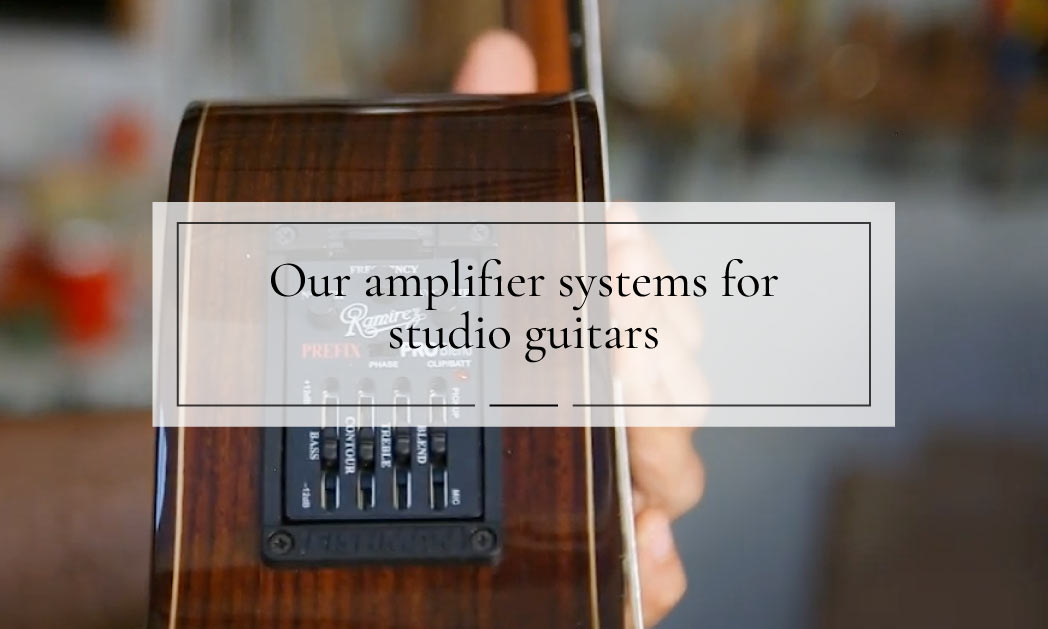In today’s article, our colleague Isaac Álvarez is going to talk about some of the amplification systems we have available for our range of studio guitars.
Arturo Lledó, an excellent guitarist and composer and a great friend of Ramírez Guitars, is also with us to explain them.
Also, before we start looking at some of our amplification systems, it is worth mentioning that they are usually installed in our Ramírez studio guitars. In artisan or handmade guitars, we use woods of exceptional quality, with a natural drying time of between 10 and 70 years, so it is better to use other systems that are not so invasive.
Fishman Prefix Pro Blend amplifier system
For the test of the amplification systems, we used the CUT 1 model (although we no longer make it, you can find another Cutaway model range in our online guitar shop).
The Fishman Prefix Pro Blend amplification system has a pickup under the bridge and a small microphone just below the console, being a hybrid system that allows the frequencies of both systems to be combined.
This system is very simple, it has a small equaliser, bass and treble, which will only affect the sound of the pickup, it does not affect the microphone.
It also allows for anti-coupling via the notch. There is also a button to adjust the frequency and a slider to adjust the contour. With the frequency button, you can set a range of different frequencies that are controlled by the contour, with which they can be emphasized or diminished.
This is mainly used for certain sound frequencies, to adjust the bass or treble, using the notch to adjust these frequencies.
Also, if we want to avoid feedback, we have to turn up the volume and when the feedback is formed, we have to turn the notch wheel slowly to the right until the feedback is eliminated. Even so, it is not advisable not to overdo it because we can eliminate other frequencies that we are interested in.
Fishman Aura Pro W/Narrow amplifier system
Another amplification system we have is the Fishman Aura Pro. The underbridge pickup is the same as the previous model, the Matrix, which has the same quality.
The difference with the previous one is that instead of a microphone, it is a simulation of different microphones in different positions. This is called “images“. That is to say, different images, where each sound image corresponds to a different type of microphone and a different position. In this case, there are 4 pre-recorded images, which offers a wide range of possibilities.
The Fishman Aura Pro amplification system has a Blend that is used to establish a balance between the pickup and the different pre-recorded images.
It also has a tuner, an anti-coupling device and a USB port. This is prepared and optimized for our Cutaway guitars, but if you are looking for a different configuration and other types of “images” with other microphones, other positions, etc., you can load an infinite number of models through the USB port.
Midi Poly Drive IV amplifier system
Another amplification system we have at our disposal is our Midi system. This allows us to separate and control directly with the console the 6 individual pickups it contains, one for each string, which picks up both the sound of the audio and the sound of the midi.
For the Midi system, what we need is a converter that transforms the signal coming from the guitar via the 13-pin Gcar cable into two signals: the standard Midi signal and the audio signal. We use the Roland GR55 which works very well.
It also has an equaliser on the console itself, where you can even select the instruments you want via the console.
It is characterised by its ease of use, the performance it provides both in life and recorded performances and the cleanliness of the pickup, something that sometimes goes unnoticed, but which is very important because it can affect the sound.
Another highlight is, for example, the double bass, which really makes it sound like a very natural acoustic.
And finally, another advantage of the Midi system is in terms of composition, because it allows us to connect it directly to a computer and in this way, using any score editor or sequencer that allows it, we can write a score in real-time with the guitar.
In the following video, you will be able to see the explanation of each of the amplification systems by our colleague Isaac Álvarez, as well as the tests and impressions of the great guitarist and composer Arturo Lledó.


